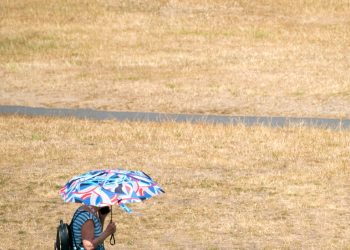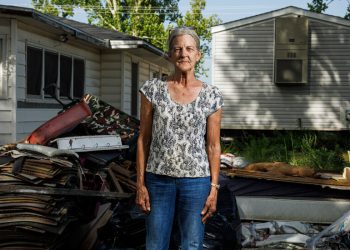RAMLA, Israel — In a subterranean reservoir, underneath the Israeli city of Ramla, the stone walls echo with an Arab-Jewish harmony at odds with the frictions of the world above.
Visitors to the medieval site, built by Muslim rulers 1,233 years ago, enter hearing the words of Jewish liturgical poetry and Arab folk songs, each sung to the same Arab music.
To listen to the composition, you descend from street level via a steep staircase, down to a turquoise pool. From a jetty at the bottom, you step into a white dinghy. Then you paddle across the carp-filled water, underneath several loudspeakers, and through an arcade of 36 stone arches that give the place its name: Pool of the Arches.
Under the speakers in the eastern arches, you can hear the Jewish poetry. Under the western arches, the Arab songs. And in the middle, a mix of the two. Each track is different, but they are mostly slow, somber melodies that blend ethereal vocals with the strumming of an oud.
“Art that brings people together,” said Jalil Dabit, one of the first visitors to the musical installation, and a member of Israel’s Palestinian minority. “Perfect for Ramla,” he added.
Any intercultural project in Israel — where many Arabs complain of systemic discrimination by Jews, and many Jews fear they will never be accepted by Arabs — has the potential to feel either resonant or contrived.
In Ramla, one of Israel’s so-called mixed cities, that potential is even greater.
Ramla was founded in the early eighth century during the Umayyad caliphate, and in the Middle Ages, it was briefly a Christian stronghold. Upon its capture by the new state of Israel in 1948, Israeli soldiers expelled thousands of Arabs from the city. Today, its population of 76,000 is an ethnic mishmash — three-quarters are Jews, one-quarter Arabs.
During ethnic unrest last year, set off by the latest Gaza war, Ramla was one of several mixed cities where there was fighting between Arab and Jewish citizens.
Against this backdrop, the local art museum, Contemporary Art Center Ramla, is attempting to address the tensions, and bring art to a city often overlooked by Israel’s cultural elite. The installation at the underground reservoir, “Reflection,” running for a year, is one of the center’s flagship initiatives.
“It gives a chance for everybody to have their own voice,” said Smadar Sheffi, the center’s director.
When the reservoir was built in 789, the city’s residents fetched water by lowering buckets from small gaps in the reservoir’s roof. Today, the project’s loudspeakers hang from the same openings.
Emanating from those speakers is a 22-minute cycle of four Arab love songs, each played simultaneously with four Jewish religious poems. All the songs and poems are at least a century old, and each of the four pairings is set to a different Arab tune.
In one matchup, an Arab folk song popularized in the 1970s by Fairuz, a Lebanese singer, is set against a Jewish poem written in the 19th century by Rafael Antebi, a Syrian-born rabbi. The Arabic song depicts a hypnotized lover while the Hebrew verse addresses an exiled Jew’s yearning for Zion.
All the songs and poems were recorded by a team of three singers — two Jewish and one Arab. Then they were blended together by Dor Zlekha Levy, an Israeli artist who led the project, and Yaniv Raba, an Israeli composer.
Mr. Zlekha Levy, 32, often focuses his work on this kind of linguistic overlap, and says he became fascinated by the relationship between Jewish and Arab culture as a teenager. His grandfather was one of more than 120,000 Arabic-speaking Jews who fled or were expelled from Iraq in the early 1950s. He continued to watch Arab films every week until he died decades later, and regularly visited Arab communities in Israel, piquing his grandson’s interest.
In 2008, Mr. Zlekha Levy visited Cordoba, the Spanish city where Muslims and Jews lived side by side in the Middle Ages. Sitting in the city’s cathedral, a former mosque near the home of Maimonides, a revered medieval Jewish philosopher, Mr. Zlekha Levy had an epiphany. He realized he wanted to make art that evoked a similar kind of cultural exchange.
It was “a kind of motivation,” he said. “I really try to recreate this kind of experience.”
To those familiar with Israel’s aboveground tensions, Mr. Zlekha Levy’s project at the reservoir could seem like a gimmick. But there is nevertheless an organic quality to it, both politically and artistically, residents and organizers said.
Within Ramla, where Arab-Jewish relations are comparatively less fraught than in some other mixed cities, the investment in the project reflects the relative willingness of the city authorities to support intercultural exchange.
During the ethnic unrest last May, the violence was contained much more quickly than in Lod, another mixed city nearby — thanks to better ties between the leaders of Ramla’s different communities, and more inclusive municipal leadership.
After the riots broke out, the city’s Jewish mayor went door to door with local Arab and Jewish leaders, persuading people to stay home. The mayor also organized a community street dinner that brought together dozens of Jewish and Arab community leaders, again salving the anger.
“I’d have to be naïve to think there aren’t challenges — we are in a conflict that has been here for generations,” said Malake Arafat, an Arab school principal in Ramla.
But there are strong bridges between Ramla’s different communities, Ms. Arafat said. “And they are embedded in the structure of daily life,” she added. For instance, she said, her Arab students participate in community projects in the school’s mainly Jewish neighborhood, and some of those Jewish neighbors come to the school’s events.
Similarly, the artistic concept of mixing the Jewish liturgy with Arab music is also a phenomenon with long roots in the real world. The practice is often heard in many contemporary synagogues run by Jews of Middle Eastern origin.
Even after moving to Israel in the early years of the state, many Jews from the Arab world, known as Mizrahi Jews, still retained an affection and affinity for the Arab songs they grew up hearing on the radio.
Religious Mizrahim wanted to use that music as part of their religious practice. In order to make it suitable for the solemnity of a synagogue, they’d take the original Arab tunes and overlay them with Hebrew lyrics, some of them written by rabbis and some taken from sections of the Torah.
Moshe Habusha, a leading Mizrahi musician, regularly performed these compositions for Ovadia Yosef, a former chief rabbi of Israel who died in 2013 and whose legacy still dominates religious Mizrahi society.
In fact, Mr. Zlekha Levy and his collaborator, Mr. Raba, used combinations of Hebrew poems and Arab tunes that were already religious Mizrahi staples.
They then adapted those combinations and recorded Jewish singers and musicians performing the new adaptations.
Separately, they recorded an Arab performer singing the Arabic lyrics of the Arab love songs, set to the same Arab music as the Jewish poems.
Finally, they decided to play the recordings of both the Jewish poems and the Arab songs side by side in the reservoir’s middle. So as you float beneath the central arches, you hear both melodies — creating the perception of a single, united composition, even though the two recordings in fact remain separate tracks, played from separate speakers.
“There’s a deep connection between the cultures,” Mr. Zlekha Levy said.
“We are not that different from each other,” he added. “And this is what also this installation explores.”
Myra Noveck and Hiba Yazbek contributed reporting from Jerusalem, and Gabby Sobelman from Rehovot, Israel.
Source: NY Times












